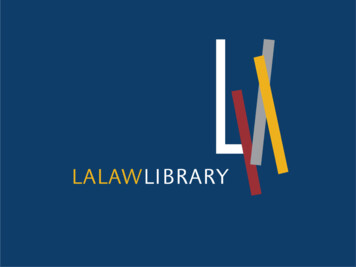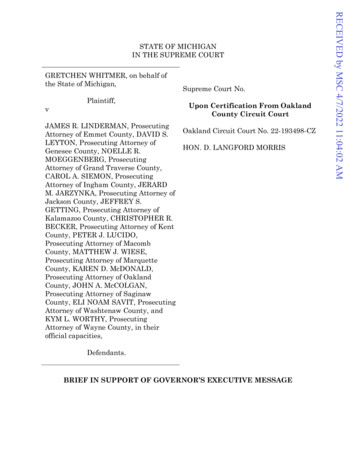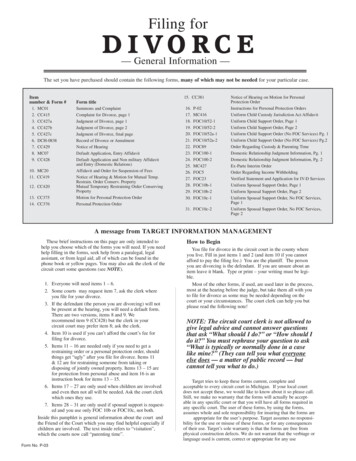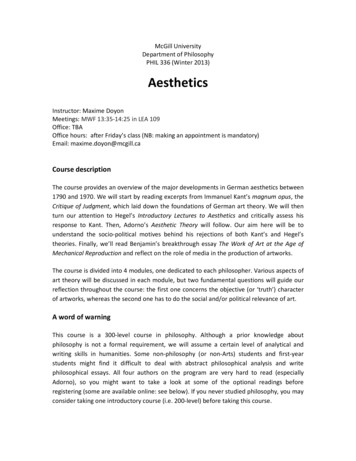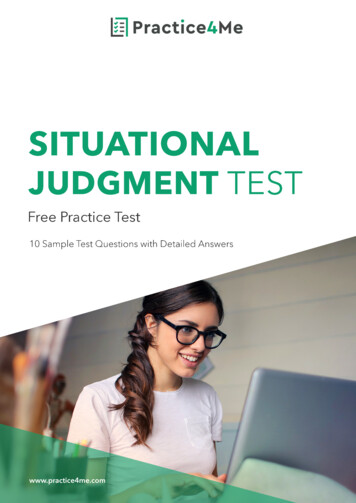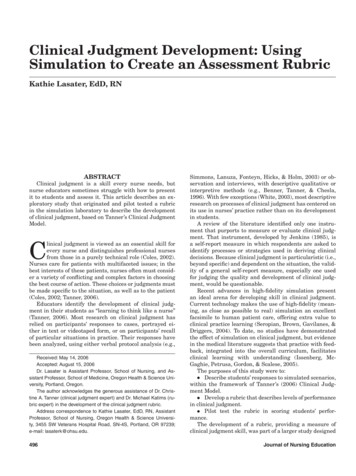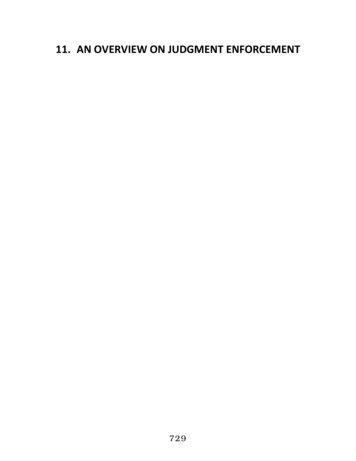
Transcription
11. AN OVERVIEW ON JUDGMENT ENFORCEMENT729
730
Judgment Enforcement OutlineI.Laying the Groundworka. Client Contractsb. Credit ReferencesII.Patience – Why You Must Have Ita. All Judgment Debtors Are Not the Sameb. Collateral PressureIII.Evaluating a Case and Collection Potentiala. The Judgment is Just the Beginningb. Collectabilityi.ii.iii.iv.Client RecordsPublic RecordsPerseverancePerseveranceIV.Managing Client ExpectationsV.Basics of Judgment Enforcementa. What Property is or is not Subject to Enforcementb. Priorities and Lien Docketingc. Four Steps You Should Take to Enforce a Judgmenti.ii.iii.iv.Docketing of TranscriptsSheriff’s Execution – income and “regular” executionsRestraining NoticesSubpoenas Duces Tecum and Ad Testificandumd. What Happens when the Judgment Debtor Ignores You?i. Contemptii. Arrestiii. Installment Payment Order731
732
Modifications to Main Text Footnote 1: “596” should read “597(b)” Footnote 11: “9-5019” should read “9-501” Section 11.7, first paragraph: the correct DMV URL is http://www.dmv.ny.gov Section 11.9: The “Commission for the United Nations, Consular Corps and Protocol”has changed its name to“The New York City Mayor’s Office for International Affairs” Section 11.12, seventh paragraph: “within 5 days, serve written redirect questions.”should read “within 5 days, serve written recross questions.” Footnote 38: “47 N.Y. 639” should read “47 N.Y.2d 639” Footnote 36 and accompanying text: The homestead exemption has increased to up to 150,000, dependant on county Footnote 93: “1692f” should read “1692p”733
734
CHAPTER TWOEVALUATING THE CLAIMSara Bulson, Esq.735
736
EVALUATING THE CLAIM[2.0]§ 2.0I. REVIEWING DOCUMENTATIONAn attorney who evaluates a claim for collection should ensure thatthe creditor has supplied all relevant documentation of the debt. Thismay include, but is not limited to, a copy of a signed application andcontract, proof of security, guarantees, invoices, statements, assignmentagreements, and correspondence from the debtor. Not only does a wellorganized file assist in evaluating the merit of the claim, it also enablesan attorney to comply immediately with consumer verification requestsand to anticipate possible defenses to the action.The attorney should also conduct a preliminary investigation of thedebtor to determine his or her status. For example, a debtor who is anactive-duty member of the military service is afforded specific protectionsunder the Servicemembers Civil Relief Act (SCRA).1 Pursuant to thisAct, the maximum rate of interest on credit obligations incurred beforemilitary service is limited to 6% during the period of military service.2 Inaddition, upon application, the SCRA provides a service member who hasnotice of a pending civil action an automatic 90-day stay.3A debtor may also be deceased, in which case the attorney shouldcheck Social Security death records4 and the appropriate surrogate’s courtfor the existence of the decedent’s estate within which to file a claim. Inthe case of a bankrupt debtor, it is essential for the attorney to identifypre-petition obligations that may have been discharged and post-petitionobligations that are fully enforceable. Of course, in the case of a pendingbankruptcy, the attorney is prohibited from taking virtually any action tocollect the debt by automatic stay, but he or she may file a claim on thecreditor’s behalf.5The attorney should also be cognizant of possible notice requirementsunder the Uniform Commercial Code (UCC) and the Bankruptcy Code.Pursuant to UCC § 2-702, a seller has a right to reclaim goods from aninsolvent buyer if demand is made within ten days after receipt. If, how150 App. U.S.C. § 501–596.250 App. U.S.C. § 527.350 App. U.S.C. § 522. Active service members can be identified by accessing www.servicememberscivilreliefact.com (last visited May 16, 2008).4Social Security Death Index Search Engine, http://www.ssdi-search.com (last visited Feb. 23,2008).511 U.S.C. 362. Bankrupt debtors can be identified by accessing www.pacer.psc.uscourts.gov(last visited May 16, 2008).13737
§ 2.0COLLECTIONS AND ENFORCEMENT—2D EDever, misrepresentation of solvency was made in writing within threemonths before delivery, this notice provision does not apply. The rights ofa reclaiming seller under state law are preserved even if the debtor shouldfile for bankruptcy relief.6Similarly, if the debt is based on materials supplied or work performedin the construction industry, there are time limits within which to file anotice of mechanic’s lien. For private improvements, N.Y. Lien Law § 10(Lien Law) requires the lien to be filed within eight months after the lastitem of work was performed. (For a single-family residential house, thetime period is shortened to four months.)7 For public improvements, LienLaw § 12 requires the lien to be filed within 30 days after the entireproject is approved and accepted.The attorney should also take note of acts constituting default underany contract and the notice requirements associated with the default. Adefault occurs not only whenever the debtor fails to tender a payment thatis due, but the contract may specify that other acts (e.g., making falsestatements on loan application, failing to maintain insurance on collateral,etc.) also constitute defaults. The attorney should give notice of defaultaccording to the specific provisions in the contract, such as by first-classmail or registered mail.An attorney who decides to undertake representation should reviewPart 1215 of the Joint Rules of the Appellate Division.8 This rule requiresattorneys to provide clients with a “letter of engagement” that must (1)explain the scope of legal services to be performed; (2) explain the feesand expenses to be charged, together with the lawyer’s billing practices;and (3) note that the client may have a right to arbitrate any fee disputethat may arise under Part 137 of the Rules of the Chief Administrator.However, there are exceptions to this rule; notably, it does not apply tomatters where the legal fee is expected to be less than 3,000.9611 U.S.C. § 546(c).7Lien Law § 10(1).822 N.Y. Comp. Codes R. & Regs. tit. 22, § 1215.1 (N.Y.C.R.R.).922 N.Y.C.R.R. § 1215.2.14738
EVALUATING THE CLAIM[2.1]§ 2.1II. IDENTIFYING POTENTIAL CAUSES OFACTIONAn attorney evaluating a claim should also attempt to identify allpotential causes of action. Many claims will undoubtedly be based uponcontract, including promissory notes, credit card purchases, and deficiency actions. In addition to identifying the rights and duties of everyparty clearly, a properly completed contract will (1) clearly identify allparties to the transaction; (2) incorporate by reference all relevant documents; (3) clearly state the additions, deletions, and modifications to theexisting contract in applicable amendments or addendums; and (4) contain the signatures of the parties to be bound.The debt may also be secured or unsecured. If the debt is secured, thesecured party has a right, upon default, to immediate possession of thecollateral. Repossession is appropriate if the collateral can be taken without a breach of the peace. However, if the attorney has reason to believethat repossession cannot be accomplished peacefully or that the collateralis being hidden, he or she should commence an action in replevin.If the claim involves a debtor and a secured party in a commercialtransaction, the attorney should examine whether the secured party hasperfected its security interest by filing a UCC financing statement.10Depending on the nature of the collateral, the proper place to file a financing statement is either (1) the office designated for the filing or recordingof a record of a mortgage on the related real property or (2) the office ofthe Secretary of State of New York.11 The secured party may file eitherthe security agreement itself or a financing statement. To be valid, thefiled document must contain (1) the names of the debtor and the securedparty and (2) a description of the collateral that “reasonably identifieswhat is described.”12 A filed financing statement is effective for five yearsfrom the date of filing. It lapses on the expiration of the five-year periodunless a continuation statement is filed within six months prior to theexpiration date.1310New York State UCC records may be searched on the Department of State’s Web site, http://www.dos.state.ny.us (last visited Feb. 23, 2008).11UCC § 9-5019(a), (b).12UCC §§ 9-502(a), 9-504, 9-108.13UCC § 9-515.15739
§ 2.2COLLECTIONS AND ENFORCEMENT—2D EDOther potential causes of action in a collection referral are claims basedon services (i.e., medical services rendered or goods, wares, and merchandise sold and delivered) or claims based on checks returned due to insufficient funds. In the case of a dishonored check, the attorney should requesta copy of the check to ascertain all liable parties, including the drawer andendorser.[2.2]III. ESTABLISHING LIABILITY—IDENTIFYING ALL PROPER DEFENDANTSThe next step in evaluating a collection claim is to identify all properdefendants. If a creditor renders services to a debtor who appears to be aminor, the attorney should identify the minor’s responsible parents orlegal guardian. In addition, the attorney should review all documentationfor guarantors on credit applications or guaranty agreements. In the caseof a corporate debt, the attorney should evaluate the capacity within whicha corporate officer signed the application or contract for evidence of anintent to be personally obligated on the debt. The attorney should alsomake an effort to identify the legal composition and correct name of thedebtor. It is important for the attorney to conduct an independent examination and not rely solely on the information provided by the creditor. Acreditor may mistakenly assume the debtor was a corporation when thedebtor was actually a person conducting business under a certificate ofdoing business under an assumed name (DBA). Whenever a debtor isinvolved in a commercial claim, the attorney should check both the NewYork State Department of State’s Web site14 and the applicable countyclerk’s office to verify that debtor’s status.[2.3]IV. STATUTES OF LIMITATIONSTogether with potential notice requirements previously discussed, theattorney must also be aware of time restraints within which an action mustbe commenced. Pursuant to N.Y. Civil Practice Law & Rules section211(b) (CPLR), judgments in New York State have a 20-year statute oflimitations. This section creates a conclusive presumption of payment if20 years have elapsed from the time the judgment was docketed, exceptwhere there is (1) a written acknowledgment of indebtedness signed bythe person to be charged or (2) a payment of all or part of the amountrecovered by the judgment. Pursuant to CPLR 211(e), an action or proceeding to enforce any order or judgment awarding support, alimony, ormaintenance must be commenced within 20 years from the date of default14 http://www.dos.state.ny.us (last visited Feb. 23, 2008).16740
EVALUATING THE CLAIM§ 2.4in payment. Actions on express or implied contracts (except those governed by UCC article 2) and any action for which there is no other specific statute of limitation must be commenced within 6 years.15 Pursuantto UCC § 2-725, the statute of limitations on a contract for the sale ofgoods is 4 years and cannot be extended by agreement of the parties, but itmay be shortened to a period of not less than 1 year.[2.4]V. JURISDICTIONJurisdiction depends on whether the referred claim is a consumer claimor a commercial claim. A consumer credit transaction is defined by CPLR105(f) as a “transaction wherein credit is extended to an individual and themoney, property, or service which is the subject of the transaction is primarily for personal, family or household purposes.” The federal Fair DebtCollection Practices Act (FDCPA) requires that all actions based on consumer credit transactions must be commenced either in the county wherethe contract was signed or the county where the debtor resides.16 In commercial claims, the attorney should review the entire contract for a forumselection clause. Depending on the particular language used, the jurisdiction agreement may be exclusive or permissive. An exclusive agreementmandates that any action based upon the contract must be brought in aparticular state’s courts, whereas a permissive agreement allows an actionto be brought in a particular state’s courts. In addition to the loss of timeand money caused by commencing an action in an improper court, thecreditor’s attorney whose case is dismissed for lack of jurisdiction alsofaces the risk of the action being time-barred. Similarly, the attorneyshould also examine the contract for mandatory arbitration clauses thatmay likewise result in dismissal of an action and raise time-bar concerns.Whenever possible, the attorney should commence the action in citycourt, which has jurisdiction over actions and proceedings for the recovery of money and actions involving chattels, and whose filing fee is 45compared to 210 to commence an action in supreme court. However, inorder to have jurisdiction, the amount sought to be recovered must be lessthan 15,000 (exclusive of interest and costs).17 In addition, pursuant toUniform City Ct. § 213(a), either plaintiff or defendant must (1) be a resident of the city or of a town contiguous to such city, (2) have a regularemployment within the city, or (3) have a place for the regular transaction15CPLR 213.16FDCPA § 1692(i).17N.Y. Uniform City Court Act § 202 (Uniform City Ct. Act).17741
§ 2.5COLLECTIONS AND ENFORCEMENT—2D EDof business within the city. Pursuant to Uniform City Ct. Act § 213(b), acorporation, association, or partnership is deemed a resident of the city ifit has an office or agency or regularly transacts business in the city.[2.5]VI. PLEADING CONSIDERATIONSIf a review of the creditor’s documentation reveals that the creditor sentinvoices and statements to the debtor, and the debtor failed to objectwithin a reasonable period of time, an independent cause of action for anaccount stated should be plead.The attorney should also thoroughly review all of the creditor’s documentation for attorney fee provisions. These may be found in credit applications or the Note. Although N.Y. Personal Property Law § 402(6-a)declares null and void any provision in a retail installment contract whichprovides for the payment of attorney’s fees incurred in a legal action orproceeding for collection, the Motor Vehicle Retail Installment Sales Actallows for the payment of attorney’s fees “not exceeding fifteen percent ofthe amount due and payable under such contract where such contract isreferred to an attorney not a salaried employee of the holder of the contract for collection, plus the court costs” if the contract so provides.18 Subject to contract limits, courts customarily award 25% of the principalbalance due as “reasonable” attorney’s fees. In addition, credit applications or agreements can also provide for a higher interest rate, as opposedto the statutory 9%.1918Personal Property Law § 302(7).19CPLR 5001, 5004.18742
CHAPTER ELEVENEVALUATING COLLECTIONPROSPECTSStephen J. Schop, Esq.**The author wishes to acknowledge the prior contributions Ronald Forster, Esq., and Jack L.Getman, Esq., as past authors of this chapter.743
744
EVALUATING COLLECTION PROSPECTS§ 11.0[11.0] I. INTRODUCTIONThe entry of a judgment by itself usually does not result in the judgment debtor appearing voluntarily and satisfying the judgment. If thejudgment is recorded or transcripted in the county in which the judgmentdebtor has real property, the judgment may result in a lien against the realproperty, but it does not produce cash for your client. It is the attorney’sresponsibility, in conjunction with the client, to evaluate the prospects ofcollecting the judgment. Since enforcement proceedings may be expensive in the way of filing fees, service of process, and examinations, it isimportant to evaluate whether the judgment debtor has nonexempt assetswhich can be levied upon or which otherwise are collectible.In order to do this, it is necessary to obtain as much information as possible about the judgment debtor and his or her assets. The techniques arereferred to as “asset locating” and “skip tracing.” If the whereabouts of thejudgment debtor are known, then the total collection process will bedirected toward locating those assets which can be subject to enforcementand satisfaction of the judgment. The attorney must be familiar with thekinds of property that are exempt from execution. Article 52 of N.Y. CivilPractice Law & Rules (CPLR) provides the mechanism for locating assetsand enforcing a money judgment, beginning with the identification ofproperty that is subject to enforcement.1Assets are broken down into debts and property against which a moneyjudgment can be enforced. The debt must be past due or yet to becomedue, certainly or upon demand of the judgment debtor, such as a timedeposit or checking or savings account at a bank. It matters not where thedebt was incurred nor whether it was to or from a nonresident. A cause ofaction capable of being assigned or transferred is a debt whether itoccurred within or without the state. Similarly, any property which couldbe assigned or transferred, vested or not, or consisting of a present orfuture right, can be the proper subject of the enforcement of a moneyjudgment. The debt or property must not be exempt from application tothe satisfaction of the judgment.Civil Practice Law & Rules 5205 covers personal property exemptions,and CPLR 5206 covers real property exemptions. Section 5222(e) of theCPLR mentions other exemptions under state and federal law.1CPLR 5201(a).229745
§ 11.0COLLECTIONS AND ENFORCEMENT—2D ED.Once all the exemptions are considered, a multitude of other assetsremain that are subject to enforcement and satisfaction of a judgment.However, there have been some interesting interpretations of CPLR 5201.In Glassman v. Hyder,2 the Court of Appeals held that future rental payments due to the judgment debtor are not a debt and not attachable, assuch rental payments are contingent with no certainty of payment. Notwithstanding this legal determination, judgment creditors across the statecommonly ask the sheriff to execute upon rents as they are paid. TheCourt of Appeals seemed to base its decision solely upon paragraph (a) ofCPLR 5201, which deals with debts, and did not consider paragraph (b),which deals with property. If future rents are not considered debts becausethere is no certainty they will become due, why should they not be considered a property right that could be assigned or transferred? This seems tomake more sense. Future rents certainly have value and, therefore, shouldbe applicable to the satisfaction of a judgment as they become due.Since a judgment creditor can execute against the real property, theissue of whether or not you can execute against the rent becomes moot.3The problem, however, in proceeding against the property is that it maynot be economically feasible. The amount of the judgment would control how to proceed. A real property execution can be costly and timeconsuming. The costs of advertising and sheriff’s fees are substantialeven though recoverable. This method is not recommended where thejudgment is relatively small. Furthermore, many courts in New York arereluctant to sell real property to satisfy a judgment, particularly if it alsohappens to be the judgment debtor’s residence.You must petition the court to permit such a sale where the value of thehome exceeds 50,000 above liens and encumbrances. Homes with avalue under this amount are exempt from execution. The courts have beenknown to invoke protective orders against a sale where the debt is disproportionate to the value of the property and may also require that otherremedies be exhausted first.4Of course, under CPLR 5228 a receiver may be appointed who couldcollect the rents and apply them toward the judgment. Again, this wouldbe time-consuming and require a lot of paperwork. Certainly it would be2Glassman v. Hyder, 23 N.Y.2d 354, 296 N.Y.S.2d 783 (1968).3David D. Siegel, McKinney’s Practice Commentary, CPLR 5201(a) (1997).4Gilchrist v. Commercial Credit Corp., 66 Misc. 2d 791, 322 N.Y.S.2d 200 (Sup. Ct.,Nassau Co. 1971).230746
EVALUATING COLLECTION PROSPECTS§ 11.0preferable if the rents could be executed against like other property. In1976, the Court of Appeals, in Abkco Industries, Inc. v. Apple Films Inc.,5may have decided just that. This case involved a licensing agreementbetween a British company and a New York company to market a filminvolving the Beatles in the United States. Under the agreement, a percentage of the profit was to be paid to the British firm. The court brushedover the contingent nature of the “debt” and treated the agreement asproperty capable of being assigned and subject to attachment. In reachingthis conclusion, the court reviewed its decision in Glassman v. Hyder.6The real property in the Glassman case was located in New Mexico, andsince the situs of a leasehold of real estate is at the location of the realestate, the property was beyond the reach of New York courts, and onlythe question of future rents as debts could be considered.It now appears possible that future rents could be reached as propertyunder CPLR 5201(b) so long as the situs of the real estate is within thejurisdiction of the New York courts. It is clear that even if levy and execution cannot be maintained under CPLR 5201(a) dealing with contingentdebts, it can be maintained if the debt can be treated as property.Property can be either real or personal. However, shares in a cooperative apartment, although not actually real property, are treated as such forpurposes of the homestead exemption pursuant to CPLR 5206. Unlike thecondominium, which is treated as real property for all purposes,7 onewould execute on a co-op by levying upon the shares of stock. The homestead exemption of 50,000 above liens and encumbrances remains ineffect for one year after payment to the judgment debtor. If the judgmentdebtor receives money as a result of a surplus money proceeding after amortgage foreclosure, there is no exemption. The surplus money becomespersonalty and is subject to execution at any time thereafter.8Regardless of how property is classified, it must be found first in orderto utilize any one of a number of judgment enforcement proceedings provided for under CPLR Article 52. In order to do this, you must use all ofthe available information at your disposal. The information you obtain539 N.Y.2d 670, 385 N.Y.S.2d 511 (1976); cf. Alliance Bond Fund v. Grupo MexicanoDe Desarrollo, 190 F.3d 16 (2d Cir. 1999) (applying Abkco holding to a case involvingU.S. investors seeking to recover on defaulted Mexican construction notes).6Glassman, 23 N.Y.2d 354.7N.Y. Real Property Law § 339-G.8First Fed. Sav. & Loan Ass’n of Rochester v. Brown, 78 A.D.2d 119, 434 N.Y.S.2d 306 (4thDep’t 1980).231747
§ 11.1COLLECTIONS AND ENFORCEMENT—2D ED.should lead to either possible assets or the realization that the judgmentdebtor is judgment proof and the claim is uncollectible for all practicalpurposes. A check of the bankruptcy filings in the debtor’s district isimportant. If the debtor has filed during the last seven years, he or shecannot file now to avoid enforcement of the judgment.The amount of effort put into collecting really is determined by thereward to be gained. The larger the debt, the greater the effort that can bemade and justified economically. Realistically, and unfortunately, amajority of claims will go unpaid, and a substantial number of judgmentswill not be satisfied. This is especially true when a claim or judgmentoriginated as a retail rather than a commercial claim. To a collection lawyer, a retail claim is made against an individual, whereas a commercialclaim is made against a business. Retail claims generally consist of sometype of consumer credit transaction. Commercial claims usually arisefrom nonpayment of goods or services used in connection with a business,and they probably are contested more often than retail claims. A judgmentagainst a commercial establishment that is still doing business shouldpresent no problems unless the assets are not subject to levy or are inconsequential as compared to the debt. An example of this would be a realestate office with just a few desks, chairs, filing cabinets, and a typewriterthat may be covered by a security agreement or lien. In such a case, effortswould be turned toward examining the debtor’s books and records to confirm the existence of cash accounts and equivalents as well as accountsreceivable. The real problem lies in tracking down the assets of individuals who are mobile and uncooperative and whose assets are not apparent.To do this, one should always begin with the client’s file.[11.1] II. THE CLIENT’S FILENearly every creditor has made some effort to collect a past-dueaccount before turning it over to a collection agency or an attorney forsuit. It is important to obtain any documentation that may be in the file.Often, the client has personal knowledge of the debtor and knows wherehe or she banks or works. There may be a credit application which hasinformation about assets and income. This is a good starting point, even ifthe application is very old and may not contain current information.Credit applications usually yield information about places of employment; banks; other income; home telephone numbers; Social Securitynumbers; and relatives’ names, addresses, and telephone numbers. TheSocial Security number is a very important means of identification, especially if the debtor has a common name or was a single woman who isnow married and using a different name. It also is useful in obtaining232748
EVALUATING COLLECTION PROSPECTS§ 11.2credit bureau reports (although it is not required for that purpose). Wherethe debtor is a “skip” (no longer at his or her last-known address), contacting relatives can be useful in helping to locate him or her. Calling an oldtelephone number can also be fruitful. Often a debtor’s residence is occupied by a relative or someone else who knows where he or she is, and adebtor’s ex-spouse often will be happy to provide his or her whereabouts.[11.2] III. PERSONAL CONTACTPersonal contact with the debtor should be attempted. Start with thewhite pages of the local telephone directory. If there is no listing, use thetelephone number in your client’s file. If you happen to make contact withthe debtor, first ascertain that the debtor is not represented by counsel andalways start the conversation by asking if there is any reason why thejudgment has not been paid. If the debtor is willing to talk, be willing tolisten. Assuming that the debtor is exempt from execution because ofbankruptcy or receipt of public assistance, the conversation should bedirected toward his or her income and employment. Any informationreceived voluntarily will result in time and expense saved.A common reason debtors give for why they have not paid their debtsis they have no money left after paying for necessities. Explore the possibilities of obtaining the resources with which to pay a judgment. Theremay be life insurance upon which money can be borrowed at a relativelylow interest rate. If the debtor is employed, he or she may be able toborrow from a credit union. Sometimes debtors feel overwhelmed by thenumber of debts they are carrying, so they ignore all of them. An attorneymight suggest the feasibility of a consolidation loan to a debtor. Somecompanies will extend credit to a person for the purpose of paying allother judgments and delinquencies, especially if the debtor’s salary andlength of employment warrant consideration. If practical, a consolidationloan would allow the debtor to make one monthly payment, and the creditor would be paid at once. This would be preferable to filing an incomeexecution that requires follow-up with the sheriff or marshal and receivingperiodic payments, provided there are no prior garnishees ahead of you. Itis important to recognize that although the direct approach may yield positive results, there is a risk that a debtor may elect to file bankruptcy.[11.3] IV. THE COLE DIRECTORIES ANDOTHER SOURCESThe more knowledge gathered about a debtor, the greater the chance ofcollecting a debt. One of the greatest tools for locating and obtaining233749
§ 11.3COLLECTIONS AND ENFORCEMENT—2D ED.information about a debtor is a Cole directory.9 Cole Information Servicespublishes a series of local directories broken down by boroughs in NewYork City and by counties outside New York City. A Cole directory combines an alphabetical street directory, including address numbers, with areverse telephone directory. A listing for a street address includes thenames and telephone numbers of persons who live at that address. Thedirectory also indicates if there is no telephone number or a nonpublishedtelephone number. A listing for a telephone number indicates to whom thenumber is assigned and his or her address.You can also find the names and telephone numbers of your judgmentdebtor’s neighbors using a Cole directory. Neighbors can be a great sourceof information. This is especially true in a small community. Other valuable information supplied in a Cole directory is a wealth code which designates the type of income area in which the debtor lives. People who livein high-income areas generally have more assets subject to execution. Thedirectory also lists the year when a listing first appeared, which couldindicate a debtor’s stability and how well known he or she might be. If heor she has lived in a multiple dwelling for a long time, the landlord maybe good source of information. Businesses and cross-streets are also indicated in Cole
211(b) (CPLR), judgments in New York State have a 20-year statute of limitations. This section creates a conclusive presumption of payment if 20 years have elapsed from the time the judgment was docketed, except where there is (1) a written acknowledgment of indebtedness signed by the person to be charged or (2) a payment of all or part of the .

